Hands-on: the ROG Zephyrus Duo 15's dual screens double the fun of gaming and creating
Today’s serious gamers need all the screen space they can get. Whether I’m running my own Twitch stream, watching another streamer, listening to Spotify, or sharing memes in my squad chat on Discord, there are many things besides games that I want to see while I’m playing. It’s easy enough to get that extra screen space on a desktop by adding a second monitor (or a third, or a fourth). When I need to game from anywhere, my options are a lot more limited.
Enter the ROG Zephyrus Duo 15. This portable powerhouse is not only home to some of the fastest hardware around. It also boasts a secondary screen that opens up new possibilities on the go. Whether you’re a serious streamer who needs room for all your tools or a content creator who needs powerful hardware for rendering projects and a color-accurate display, the Zephyrus Duo takes portable computing to a whole new level.
I’ve spent the last few weeks with this one-of-a-kind gaming laptop, and it’s changed the way I work and play, no matter where I am.
| ROG Zephryus Duo 15 | ||
|---|---|---|
| Availability (US) | Availability (CA) | |
| GX550LWS-XS79 |
Newegg Abt Amazon B&H Micro Center Microsoft Staples |
Amazon Best Buy Canada Computers Memory Express |
| GX550LXS-XS96 |
Amazon EXcaliberPC HIDevolution XoticPC |
|
| GX550LXS-XS99 |
Newegg Amazon B&H Microsoft Staples |
|
Dual-screen beauty
When I first lifted the ROG Zephyrus Duo 15 out of the box, I was surprised by how sleek and subtle its magnesium-aluminide body looked. At less than an inch thin and a little over five pounds, the razor-thin profile gives little indication of the raw power inside. When it’s closed, this laptop is a chameleon that can blend in with almost any environment. But when I open the lid to reveal what’s hidden beneath, it does anything but blend in.
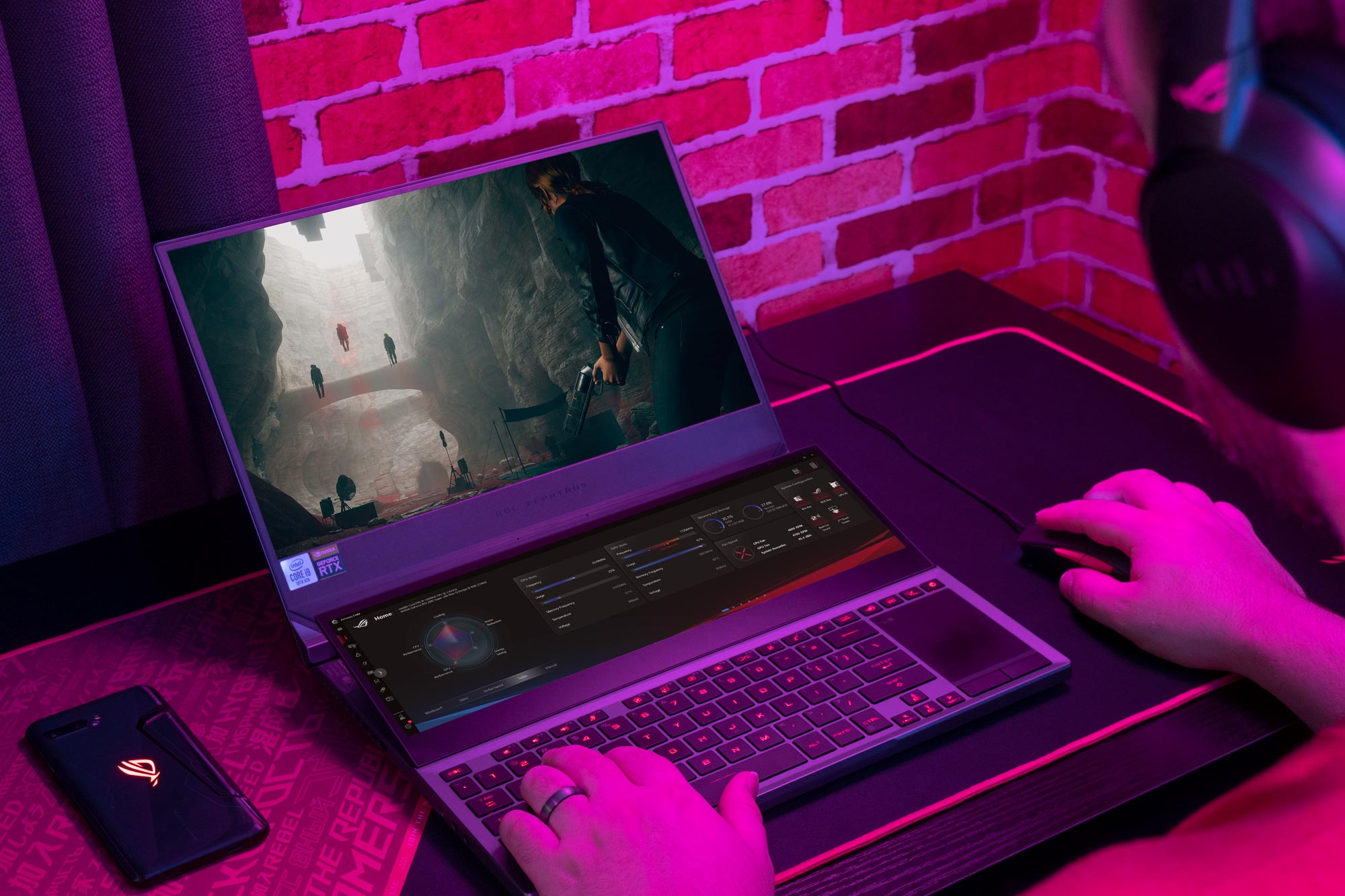
Lifting the lid of a laptop isn’t usually an exciting activity, but each time I open up the Zephyrus Duo, it brings a smile to my face. When it’s roughly a third of the way open, the dual screens come to life, revealing that this is no ordinary laptop. But that’s just the beginning of the show. The 14” ROG ScreenPad Plus then gently rises up from the body of the notebook and locks into place. The mechanism is so fluid that the laptop almost feels like it’s coming to life as it transforms into a full-fledged gaming machine.
Once it’s risen into place, the secondary 3840 x 1100 ROG ScreenPad Plus sits at a comfortable 13-degree angle—ideal for looking at everything from text to YouTube videos. But this transformation doesn’t just position the ROG ScreenPad Plus at the optimal viewing angle. It’s also a part of our Active Aerodynamic System Plus (AAS+) thermal design. When the second screen rises, it opens up a large 28.5mm air intake that allows the fans to draw cool air into the system from above. Combined with our use of a liquid metal thermal compound, the AAS+ design gives the Zephyrus Duo greater cooling capacity that can be used how I want, whether it’s for quiet running in the Silent Operating Mode, maximum performance in Turbo, or just the right balance of speed and silence in Performance Mode.
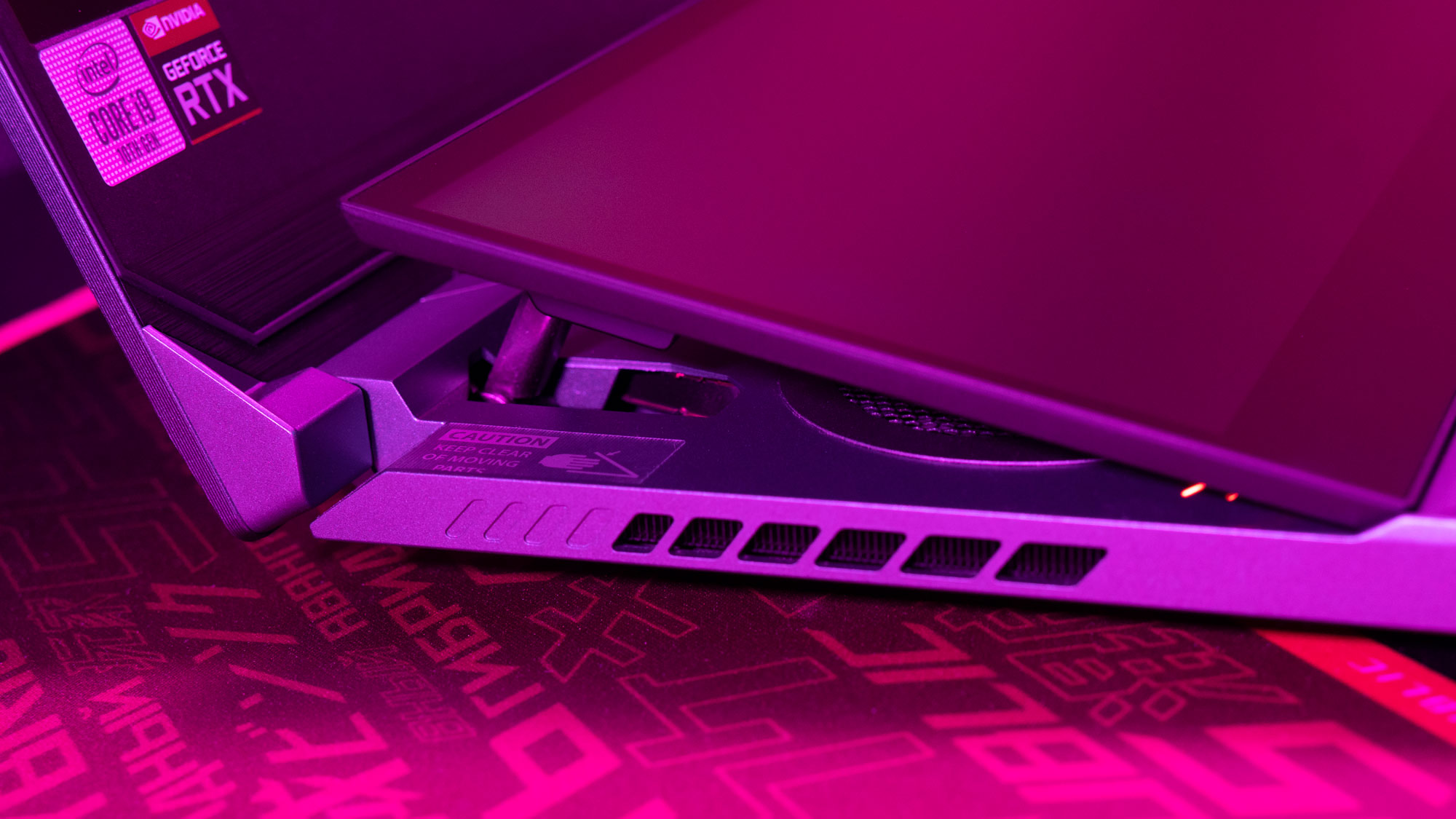
To make room for the ROG ScreenPad Plus and the AAS+ cooling design, we moved the keyboard and trackpad all the way to the front edge of the chassis. I typically prefer to type without a wrist rest, so this design feels natural when I’m using it on a desk or table. I especially appreciate the grouping of the function keys, which is reminiscent of a desktop layout. It’s easy to find and activate them without retraining my muscle memory.
The ROG ScreenPad Plus isn’t the only eye-catching display on the Zephyrus Duo 15. The main screen is a stunning 4K IPS panel that features a low 3ms response time and NVIDIA G-SYNC for smooth gameplay without the limitations of traditional Vsync. If you aspire to be part of the esports elite, you can get your own Duo 15 with a Full HD IPS panel that refreshes at a scorching 300Hz. This panel also benefits from G-SYNC tech.
Since I’ve been using the Duo 15 for some of my personal creative projects, I appreciate that the 4K screen also covers 100% of the Adobe RGB gamut. Both it and the 300Hz FHD panel are PANTONE Validated and factory calibrated, so I know my work will look consistent when viewed on other displays. But most of all, I enjoy the way games like Microsoft Flight Simulator jump to life on the brilliant 4K display.
Under the hood
The ROG ScreenPad Plus is what initially drew me to the Zephyrus Duo, but the hardware under the hood is enough to make me feel like I’m using a desktop virtually anywhere. This laptop packs an Intel Core i9-10980HK CPU with a boost clock of up to 5.3GHz, and an NVIDIA GeForce RTX 2080 SUPER GPU with a boost clock of 1330MHz. The high GPU clock speed is possible thanks to our ROG Boost design approach, which uses higher clocks and wattages than baseline implementations of the same GPU. In turn, ROG Boost is enabled by the Duo 15’s Active Aerodynamic System Plus thermal design. It’s all guided by Intelligent Cooling, a philosophy that we use to carefully tune the cooling hardware and the software that controls it for the best performance from each ROG notebook.
The Zephyrus Duo 15 is also one of the first laptops approved to use ultrafast DDR4-3200 RAM with the latest Intel CPUs. Mine came equipped with 32GB of it—more than enough to handle all my work and play. To ensure that disk read and write speeds don’t hold me back, the Zephyrus Duo sports a pair of NVMe SSDs running in a RAID 0 configuration with a total capacity of up to 2TB. Even after the latest Call of Duty updates, there’s still plenty of space to spare.
In all, there’s more power and more screens in this one machine than I’ve enjoyed in any other portable system. And I’ve been taking full advantage of that potential over the past few weeks.
Doing more with dual displays
I spend most of my days in front of multiple screens because for me, more monitors mean more productivity. Between my regular work, gaming, and my other creative projects, though, I’ve probably been spending a little too much time in my office. I don’t often take my work with me because I rely so much on a second monitor. So when the Zephyrus Duo 15 showed up on my doorstep, it was exactly what I needed to break out of my usual workflow.

Whether I’m writing articles or testing new hardware, all of the work I do benefits from a second display. I’ll often have an outline or some research pulled up in another window while I’m writing so I can find information with just a quick glance. Placing these windows down on the ROG ScreenPad Plus keeps the 4K primary display free of clutter while still allowing me to glance down at my notes. When I’m bouncing from room to room, I’ll also keep my Spotify or YouTube windows tucked away on the second screen where they can be accessed quickly when needed.
The Zephyrus Duo 15 packs an incredible amount of power, but I don’t need it all when doing lighter tasks like researching and writing. Thanks to our exclusive GPU switch in Armoury Crate, I can pop the Zephyrus Duo into NVIDIA Optimus mode during more typical tasks. By only firing up the discrete GPU when needed, Optimus extends battery life and gives me plenty of time to enjoy dual displays on my couch or back porch. The same switch enables G-SYNC mode for smoother gaming when I’m ready to switch from work to play.
Bringing games to life with a second screen
When I’m gaming, I use a secondary display not for the game itself, but for one of the many other programs that I might need to access. I usually have Discord, Spotify, and a Chrome tab open for team communication, background music, and watching YouTube or quickly searching out in-game strats. And it just so happens that the Zephyrus Duo’s second screen is the perfect size to keep these three windows open side-by-side. Thanks to our ScreenXpert software, I can snap one, two, or three windows perfectly across the screen without wasting time fiddling so that they fit just right.
Microsoft Flight Simulator
For my first taste of the Zephyrus Duo 15’s gaming power, I fired up Microsoft Flight Simulator. This title is so beautiful that I couldn’t resist taking flight on the stunning 4K screen. What’s more, Flight Simulator lets me take advantage of the ROG ScreenPad Plus by popping several of my instruments out into their own window. Instead of adjusting my in-game view to check my gauges, I can simply glance down at the second screen and see everything I need.

Flight Simulator pushes even the most robust desktop hardware to its limits, but I find that simulation games like this tend to benefit from higher fidelity over raw framerates. As I fly through the air, I don’t notice the refresh rate nearly as much as I do the beauty of the landscape below me. The Zephyrus Duo 15 is able to push out steady framerates with Medium settings at 4K, which is an impressive enough feat. Thanks to NVIDIA’s G-SYNC technology, the gameplay stays silky-smooth and tear-free, leaving me free to immerse myself in the sights below.

If you’re curious about playing Microsoft Flight Simulator on even more portable screens, you can find more about it in our hands-on piece. Spoiler: You can add the ROG XG17AHP monitor to the Zephyrus Duo 15 for the ultimate three-display portable gaming setup.
Control
Control is a gorgeous and demanding game that takes full advantage of ray-traced effects, and it’s another perfect fit for the Zephyrus Duo and the RTX 2080 SUPER’s hardware-accelerated raytracing support. Combined with NVIDIA’s DLSS 2.0 AI upscaling technology, I’m able to crank up the resolution to 4K and turn on the game’s raytracing settings while keeping frame rates steady.
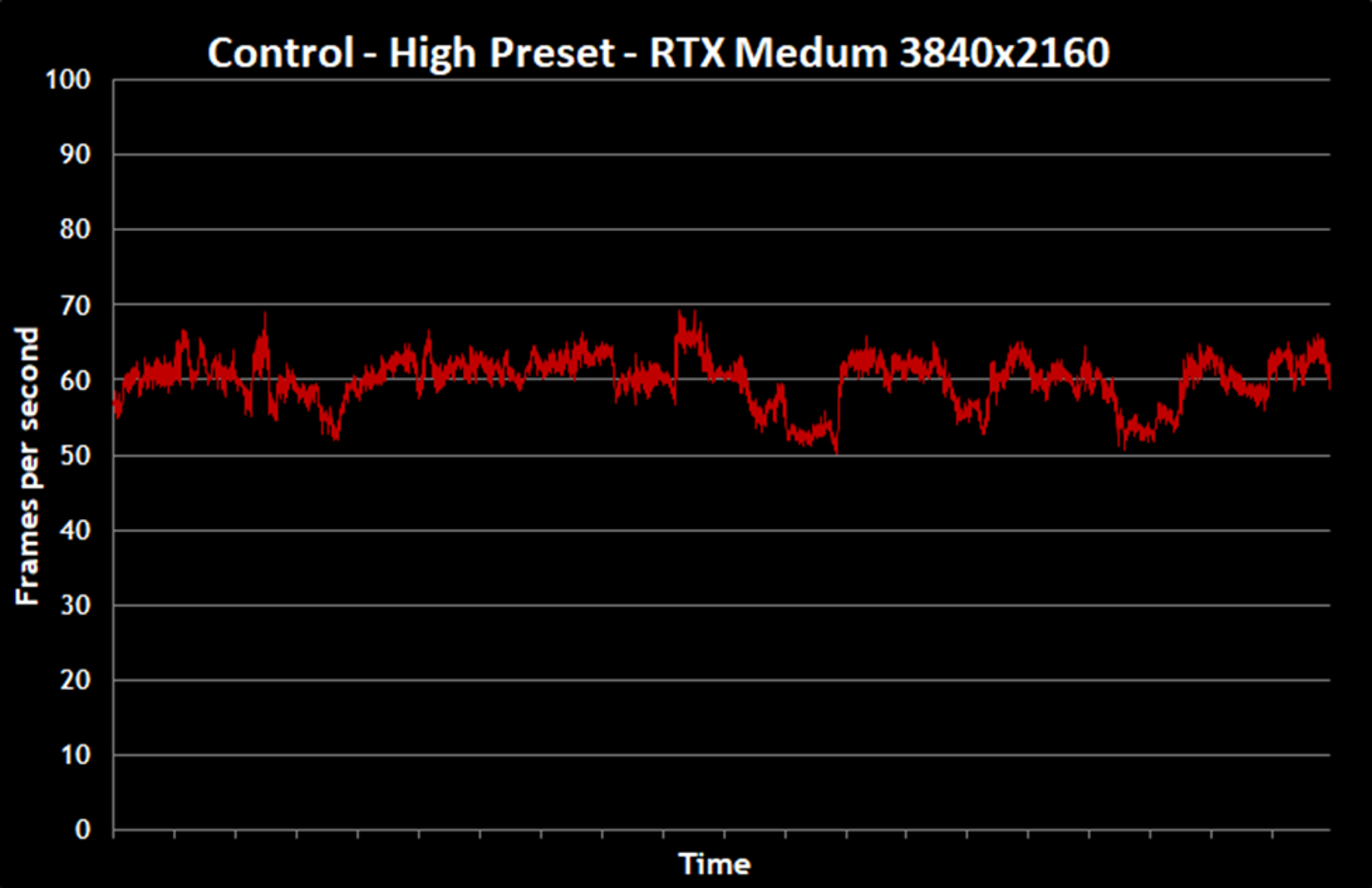
The Zephyrus Duo 15’s G-SYNC support puts extra polish on Control’s acres of shiny glass and marble. It refreshes the display only when a new frame is ready, eliminating the stuttering and tearing that can happen when frame rates dip below the monitor’s native refresh rate. Since 4K gaming can be difficult on even the fastest mobile GPUs, G-SYNC makes the game feel silky smooth even while I’m taking advantage of the beautiful 4K resolution and power-hungry features like real-time raytracing.
The perfect portable streaming solution
I like to have a lot of irons in the fire, so I’ve been experimenting with streaming games on Twitch while saving the files locally for use in other projects. Streaming and recording on one system that’s also running a modern AAA title is a taxing challenge, and it’s also frustrating to attempt on a single screen. The Zephyrus Duo 15’s dual displays make it uniquely suited for use as a mobile streaming system.
When I’m live, I want to be able to see the stream chat and have easy access to my OBS controls at the bare minimum. Both of these windows fit snugly on the ROG ScreenPad Plus, meaning I don’t have to sacrifice any space on the main screen above. Since the secondary display is also a touchscreen, it’s easy to tap on a button in OBS to switch scenes without having to Alt-Tab out of the game.
The extra screen space makes streaming convenient on the Zephyrus Duo 15, but it’s what’s under the hood that provides the horsepower to get the job done. To see what the Duo 15 could do, I started a blind playthrough of Death Stranding for my loyal fans. The RTX 2080 SUPER has enough power to run this game smoothly at 4K while also encoding the video for the Twitch stream.

Two NVIDIA technologies help make it possible to play Death Stranding at 4K while streaming it to an audience using the Zephyrus Duo 15. The first is DLSS 2.0 upscaling, which lets me run Death Stranding at 4K with high frame rates. I played with the game’s graphics settings cranked all the way up to Very High and still hit around 90 FPS—all while streaming and recording.
NVIDIA’s NVENC media engine uses a high-quality dedicated encoder to create the Twitch stream with only a minimal impact on in-game frame rates. Since the NVENC encoder doesn’t consume CPU or GPU resources, I can stream a game like Death Stranding at a high quality level for my audience while maintaining high performance for my own enjoyment.
Most games aren’t limited by a CPU like the Intel Core i9-10980HK at 4K, but offloading the stream to the NVENC encoder lets the CPU play a vital role in my streaming process. Since I want the cleanest version of my audio and video saved after each session for use in my other projects, I need the power to record the footage using x264 software encoding in OBS. This could be a deal-breaker on other systems, but the eight-core, 16-thread Core i9-10980HK can keep up with the demands of high-quality software encoding without a noticeable impact on my gameplay. Having 2TB of storage at my disposal means I don’t have to worry about running out of room for my footage, either.
Even with a game, a stream, and local recording running all at once, the Zephyrus Duo 15 never felt like it was breaking a sweat. I’d never considered trying to stream and record gameplay on a laptop before, not just because the workload itself requires such powerful hardware, but also because I would need to invest in a second portable screen to run my show. The Zephyrus Duo 15’s unique blend of power, portability, and screen real estate has me thinking about all the places I can stream from in the future.
Bringing characters to life on the big screens
I’ve recently been pouring my time into a new hobby: animation. A lot goes into even a short animated video, from designing characters and storyboarding to animating and editing clips. I do most of my linework on a tablet before moving to my PC, where I use Adobe Photoshop, Character Animator, and Premiere for everything else. And thanks to the Zephyrus Duo, I can do all of that work from anywhere.
Once I’ve finished the linework, I like to put my tablet away and focus solely on my PC rather than juggling my files back and forth. I’ll often find issues with the linework on the larger desktop display that I didn’t catch when doing my initial sketches. Most of the time, I’ll save the file in the cloud and pull my tablet back out to tackle those touch-ups. But thanks to the Zephyrus Duo 15’s secondary display, I don’t have to.

Right off the bat, the Zephyrus Duo 15 improves my existing workflow without chaining me to my desk. The ROG ScreenPad Plus supports styluses like the optional ASUS Pen. With that pen in hand, I can sketch out new linework and touch up any trouble spots in seconds. When I try to fix lines with a mouse or bounce back and forth between a regular PC and my tablet, I can lose several minutes of focus each time, killing my flow state.
After I’ve cleaned up the linework and prepared the character puppet file, it’s time to rig it up in Adobe Character Animator. It’s at this point in my process that a two-screen setup becomes a necessity. When I update PSD files in Character Animator, those changes appear in Photoshop as soon as I save them. Sometimes, I’ll bounce between these programs a dozen times before everything looks right, and I prefer not to do it on a system where I can’t see both apps at once.
The ROG ScreenPad Plus saves the day again by giving me space to lay out my puppet in Photoshop while I work on making it move and talk on the main display in Character Animator. I can also integrate touch-ups into this part of the process because of the secondary screen’s stylus support. I don’t have to endure the hassle of bouncing files back to my tablet and breaking my flow.
Most of my process up until now has relied on the Zephyrus Duo 15’s dual displays, but the final stages of animation are where its powerful hardware really comes into play. Running Adobe Character Animator can chew up some system resources, especially while I’m using facial tracking to get the right expressions for my characters. But it’s the encoding stage that takes advantage of the power inside.
My animations are still pretty short at this point, but nothing kills my flow like waiting around for a file to export from Character Animator before putting the final touches on it in Premiere Pro. The Zephyrus Duo 15 chews through my exports with ease, letting me add effects and other elements into the final video with minimal delay.
Premiere Pro is known for using a lot of system resources, especially if the clip uses a lot of effects. The program runs smoothly for me on the Zephyrus Duo and keeps pace with my desktop when it comes to final render times. And the ScreenPad Plus makes it possible to move the timeline down to the secondary display, freeing up a considerable amount of space on the primary display for 4K editing. That’s simply not possible on the single-screen laptops I’ve used.
There’s no part of my workflow that the ROG Zephyrus Duo 15 can’t handle. It’s been a literal breath of fresh air to take my projects out onto my back porch and work on them with the same ease as I could in my office.
| GX550LWS-XS79 | |
|---|---|
| CPU | Core i7-10875H |
| Display | 300Hz FHD |
| GPU | GeForce RTX 2070 SUPER |
| Memory | 32GB DDR4 |
| Storage | 2TB RAID (1+1 SSD) |
| MSRP (USD) | $2,999.99 |
| US |
Newegg Abt Amazon B&H Micro Center Microsoft Staples |
| MSRP (CA) | $3,999.99 |
| Canada |
Amazon Best Buy Canada Computers Memory Express |
| GX550LXS-XS96 | GX550LXS-XS99 | |
|---|---|---|
| CPU | Core i9-10980HK | |
| Display | 300Hz FHD | 60Hz UHD |
| GPU | GeForce RTX 2080 SUPER | |
| Memory | 16GB DDR4 | 32GB DDR4 |
| Storage | 1TB SSD | 2TB RAID (1+1 SSD) |
| MSRP (USD) | $3,499.99 | $3,699.99 |
| US |
Amazon EXcaliberPC HIDevolution XoticPC |
Newegg Amazon B&H Microsoft Staples |
Work and play with two screens everywhere
For someone like me, whose work and play demand dual displays, then there’s no better notebook than the ROG Zephyrus Duo 15. The powerful Intel Core i9-10980HK CPU and NVIDIA GeForce RTX 2080 Super GPU are enough to power any game or 3D rendering software I’ve thrown at it. That’s thanks in part to our Active Aerodynamic System Plus thermal design, which allows the CPU and GPU to unleash power that’s closer to a desktop than what I’d expect from a laptop this portable.

The hardware inside might be impressive, but it’s the ROG ScreenPad Plus that unlocks this machine’s full potential. This secondary touchscreen opens up room to do more in gaming, content creation, and desktop workloads no matter where I am. Gone are the days of Alt-Tabbing between applications or trying to share a single screen when I’m on the road or away from my desk.
Whether I want extra screen space for chat windows and tools, or extra horsepower for demanding games and apps, the Zephyrus Duo 15 has what I need to get through any task. If you’re a multi-monitor fiend like me, you owe it to yourself to give this unique system a try.
Autor
Popular Post

How to boost gaming performance on the ROG Ally

15 tips & shortcuts to set up and optimize your ROG Ally
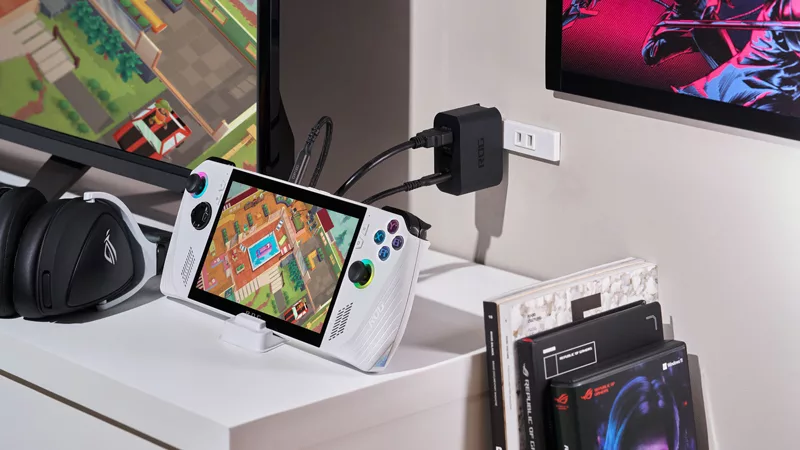
How to connect the ROG Ally to a TV or monitor for big screen gaming

ROG Elite - program nagród już dostępny w Polsce! Zgarniaj unikalne prezenty od Republiki

How to overclock your graphics card with GPU Tweak III
Najnowsze Artykuły

The Zephyrus M16 blends outstanding HDR gaming performance with undeniable luxury
The new ROG Zephyrus M16, with its Nebula HDR display, is like bringing a high-end home theater gaming setup with you wherever you go.

Radeon graphics and a stellar new display reinvigorate 2022 ROG Zephyrus G14
For a long time, I had to choose between underpowered ultraportable laptop and large laptops capable of gaming. But the ROG Zephyrus G14 puts admirable gaming chops into an ultra portable machine that travels anywhere.

Ready to rumble out of the box: Hands-on with the ROG Strix SCAR 15
Living on the move or in a smaller space isn't a roadblock to high-end gaming. The ROG Strix SCAR makes portable powerful.

Hands-on: the ROG Flow X13 transforms from ultraportable to ultra-powerful
Live the eGPU dream with the ultraportable ROG Flow X13 and XG Mobile.

Hands-on: The compact, lightweight ROG Keris Wireless sharpens competitive play
Slim, light, and responsive, the ROG Keris Wireless offers championship-level performance.
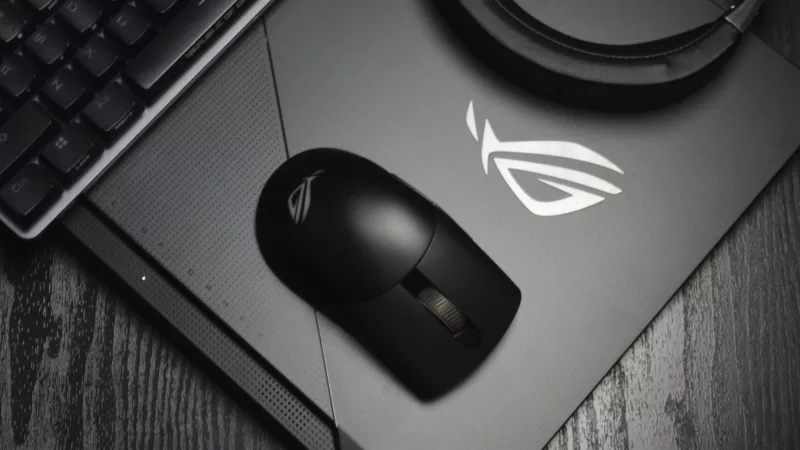
Hands-on: The ROG Zephyrus Duo 15 SE makes on-the-go gaming and streaming a snap
The ROG Zephyrus Duo 15 SE’s integrated second screen and powerful internals combine for a laptop that does more.